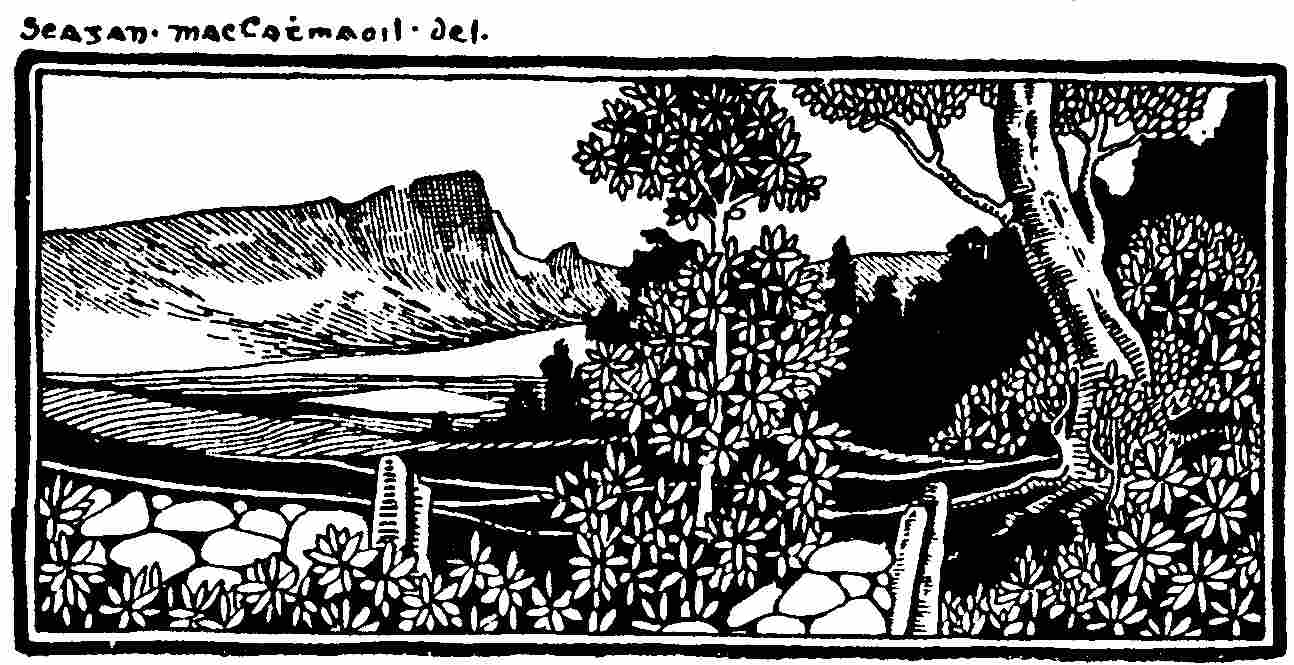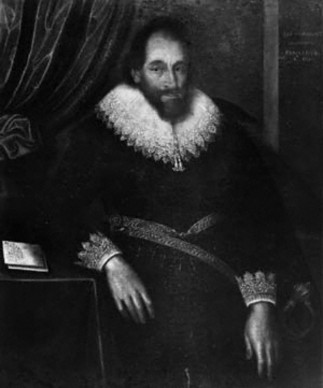On this page:

The Blue Hills of Antrim.
A fine woodcut by John Campbell from Songs of Uladh, 1904
Historical Background
The name BYERS is said to be of occupational origin, deriving from the Old English word bȳre (a stall or cattle shed).
When surnames became the norm, they were often derived from the locality where people lived.
The Byers surname has its roots in Scotland where it comes from the old barony of Byers in East Lothian, adjacent to Edinburgh, and simply means “of Byers”.
The Byers surname certainly goes back into the dim and distant past:
John de Byres was a monk in Neubotle, Midlothian, in 1309.
Thome de Byris owned a tenement in Edinburgh in 1392;
John Byres, an eminent Edinburgh merchant, treasurer, dean of guild, and provost, died in 1639.
In 17th century Scotland, the Byers name was prominent in Dumfries and Galloway.
The 1881 census confirms that Byers families were then most numerous in three areas:
- Dumfriesshire in Scotland with 202 people,
- Cumberland in the North of England with 217, and
- Co. Durham, north-east England, with 205.
1606 Settlement and 1610 Plantation of Ulster
It is doubtful that
we will be able to trace the precise Scottish roots of the Byers
families who settled in the north of Ireland, never mind determining who
the earliest Byers settlers were.
Byers family members came from Scotland to the north of Ireland to work as tenant farmers under Sir James Hamilton from Lanark, and Hugh Montgomery, 6th Laird of Braidstane of Ayrshire.
See the Co. Down Rent-Rolls listed under 17th century sources.
In 1606 Hamilton and Montgomery were granted vast areas of lands, mainly in Co. Down. In Hamilton's case this was for helping King James VI of Scotland (son of Mary, Queen of Scots) succeed Queen Elizabeth I in 1603 and become King James I of England.
The success of that Hamilton-Montgomery settlement of Co. Antrim and Co. Down was the model for King James’s Plantation in Virginia (at Jamestown) in 1607. Many of the earliest planters across the Atlantic were Ulster-Scots and there are references to Byars/Byers families in the history of Pennsylvania, Virginia and North Carolina.
The 1606 Settlement provided the inspiration for the Plantation of the rest of Ulster from around 1610, taking in large parts of counties Cavan, Armagh, Fermanagh, Tyrone, Donegal and Coleraine (Co. Coleraine was incorporated into the new county of Londonderry in 1613).
Hamilton’s new territory consisted of the entire River Bann and the area around Coleraine, as well as a major part of Co. Down which included Bangor, part of Comber, Killyleagh, Dundonald and some of the Ards Peninsula.
Montgomery had been a mercenary in the wars in Holland; his new territory included Newtownards, Donaghadee, part of Comber, Greyabbey and a large portion of the Ards Peninsula.
See also the Ulster-Scots Agency website about the Hamilton-Montgomery Settlement.
The Hamiltons
Sir James Hamilton was one of the first Fellows of Trinity College Dublin.
He was the eldest son of Hans Hamilton (1536-1608), the first Protestant vicar of the church in Dunlop in Ayrshire, Scotland.
Hans’s six sons were James, Archibald, Gawin, John, William and Patrick.
Gawin, John, William and Patrick later followed James to Ulster and established estates.
The Hamilton manuscripts (dating from the end of the 17th century) declare that the family “abounded in natural affection toward each other”.
Pic: James Hamilton, first Viscount Claneboy (c.1560-1644), artist unknown, 1628.
Source: Castle Ward, the Bangor Collection (The National Trust) here.

Cavan and the Hamiltons
Two of the Cavan baronies (Clankee and Tullyhunco) were allocated to Scottish “undertakers” or Planters in the 1610 Plantation. By 1618 some of these original grantees had sold off their lands to three of the Hamilton brothers: Sir James, William and John.
It was John, Hans Hamilton’s fourth son, who acquired land at what became Hamiltonsbawn and Newtownhamilton in Co. Armagh and in Coronary [Corroneary], Co. Cavan, “of a considerable value, on which he lived very plentifully and creditably,” according to the Hamilton manuscripts.
David Dobson’s 2001 publication, Scots-Irish Links 1575-1725, records “John Hamilton with 1,000 acres in Killochan [Killycloghan?], County Cavan, 28 March 1619 (Carew Mss# 211/2); of Corronery [Corroneary], County Cavan, was granted Irish denization, 29 July 1629 (IPR)”.
Sir James Hamilton’s main interest was in his Co. Down lands, while William who acquired Drummock in Cavan also owned land in the Ards peninsula in Co. Down.
In 1611 Sir James Carew was commissioned to write a report on the plantation’s progress, and a similar report was commissioned in 1618 from Sir Nicholas Pynnar (Pynnar used the term British, not differentiating between Scots and English, though it appears that most of the Scottish-leased proportions had Scottish tenants).
- In 1613 it was estimated that there were 70 British adults living on proportions in Cavan administered by Scots.
- By 1619 there were 665 British adults there (a remarkable growth) – 140 of them having come from Sir James Hamilton’s estates in Co.Down, and fairly definitely Scots (Sir James had acquired Lord Aubigny’s Cavan estate).
M. Perceval-Maxwell, Routledge & Kegan Paul Ltd., 1973)
With a number of Scottish families coming to Cavan from their initial settling in Co. Down, perhaps there was a Byers family among them.
Interestingly, when Sir James Hamilton sold his estate in 1621, about half of his Scottish tenants returned to Co. Down so as to remain Hamilton tenants.
A 1622 survey noted that some settlers had “left the land … and were gone to dwell in the Clandeboyes from whence they came.”Scottish numbers in Cavan certainly dwindled during the 1620s.
William Roulston, writing in Culture and Society in Early Modern Breifne/Cavan, edited by Brendan Scott (Four Courts Press, 2009), notes that by 1630-31 there were 200 Scottish men living on Scottish-owned estates in Cavan and probably 60 to 80 families. On English-owned estates there were perhaps another 44 Scottish men: “The number of Scots living in Cavan by 1630, therefore, was smaller than in any other plantation county and the second smallest, after Monaghan, of any county in Ulster.”
Bailie and Hamilton intermarriages
In 1610, William Bailie from Ayrshire, an "undertaker", was granted 1,000 acres in Toneregie, now Tandragee, in the Barony of Clankee in Co. Cavan. He was required to settle some Scottish families and to build a bawn, within which was to be built a castle.
This was Bailieborough Castle, close to the site of what would eventually develop as the town of Bailieborough.
William’s eldest son, also called William, became the Bishop of Clonfert. His other son, Robert, was a soldier and commanded a troop of Scottish soldiers in Cavan.
The Bishop of Clonfert’s daughter, Jane Bailie, married John Hamilton’s second son, James Hamilton of Bailieborough (c.1610-c.1648), in 1639.
Following the 1641 rebellion when Bailie’s Castle was attacked and captured by the Irish, Bishop William inherited the castle after his father’s death around 1648.
Another of the Bishop’s daughters, Anne Bailie, married James Hamilton, the third son of John Hamilton of Corroneary Castle, Knockbride, and it was he who then inherited Bailieborough Castle in 1666.
Between William Bailie sen. and the Hamiltons, there may well have been plenty of opportunities for one or more Byers families from either Scotland or from Co. Down to settle in this area of Co. Cavan.
Questions and Answers?
Were there any Byers families in Cavan before the 1641 rising which then considerably reduced the number of settlers?
In the absence of any documented evidence, perhaps it’s more likely that one or more Byers families arrived in east Cavan in one of the subsequent waves of migration after 1650 -
- not least, during the 1670s and 1680s when the Covenanters (staunch Presbyterians) were further suppressed, particularly in south-west Scotland;
- and during the succession of bad summers and spring frosts in the 1690s which ruined the harvests and led to famine and depopulation in Scotland.
Certainly by the 18th century there was a sizeable cluster of Byers families in Co. Down and another in Co. Cavan.
How many might have been related?
How many might trace their origin to just a few original settler families?